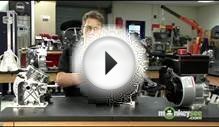
The oil pump in an internal combustion engine circulates engine oil under pressure to the rotating bearings, the sliding pistons and the camshaft of the engine. This lubricates the bearings, allows the use of higher-capacity fluid bearings and also assists in cooling the engine.
As well as its primary purpose for lubrication, pressurized oil is increasingly used as a hydraulic fluid to power small actuators. One of the first notable uses in this way was for hydraulic tappets in camshaft and valve actuation. Increasingly common recent uses may include the tensioner for a timing belt or variators for variable valve timing systems.
The type of pump used varies. Gear pumpstrochoid pumps and vane pumps are all commonly used. Plunger pumps have been used in the past, but these are now only used rarely, for small engines.
To avoid the need for priming, the pump is always mounted low-down, either submerged or around the level of the oil in the sump. A short pick-up pipe with a simple wire-mesh strainer reaches to the bottom of the sump.
Pump drive[edit]
For simplicity and reliability, mechanical pumps are used, driven by mechanical geartrains from the crankshaft. Reducing pump speed is beneficial and so it is usual to drive the pump from the cam (if this is mounted in the cylinder block) or distributor shaft, which turns at half engine speed. Placing the oil pump low-down uses a near-vertical drive shaft, driven by helical skew gears from the camshaft. Some engines, such as the Fiat twin cam engine of 1964, began as OHV engines with an oil pump driven from a conventional camshaft in the cylinder block. When the twin overhead cam engine was developed, the previous oil pump arrangement was retained and the camshaft became a shortened stub shaft. Even when the distributor position was moved from the previous block-mount to being mounted on the cylinder head camshafts, the oil pump drive remained in the same position, the unused distributor position now covered by a blanking plate.Small engines, or scooters may have internal gear pumps mounted directly on their crankshaft.
For reliability, it is rare to use an external drive mechanism, either a separate belt drive or external gears, although camshaft-driven pumps often rely on the same timing belt. Additional separate belts are sometimes used where pumps have been added to engines during tuning.
Electric oil pumps are not used, again for reliability. Some 'turbo timer' electric auxiliary oil pumps are sometimes fitted to turbocharged engines. These are a second oil pump that continues to run after the engine has stopped, providing cooling oil to the hot bearings of a turbocharger for some minutes, whilst it cools down. These are supplementary pumps and do not replace the main, mechanical, oil pump.
Lubricating system[edit]
The oiling system addresses the need to properly lubricate an engine when it’s running. Properly lubricating an engine not only reduces friction between moving parts but is also the main method by which heat is removed from pistons, bearings, and shafts. Failing to properly lubricate an engine will result in engine failure. The oil pump forces the motor oil through the passages in the engine to properly distribute oil to different engine components. In a common oiling system, oil is drawn out of the oil sump (oil pan, in US English) through a wire mesh strainer that removes some of the larger pieces of debris from the oil. The flow made by the oil pump allows the oil to be distributed around the engine. In this system, oil flows through an oil filter and sometimes an oil cooler, before going through the engine’s oil passages and being dispersed to lubricate pistons, rings, springs, valve stems, and more.
Oil pressure[edit]
The oil pressure generated in most engines should be about 10 psi per every 1000 revolutions per minute (rpm), peaking around 55-65 psi.
Local pressure (at the crankshaft journal and bearing) is far higher than the 50, 60 psi &c. set by the pump’s relief valve, and will reach hundreds of psi. This higher pressure is developed by the relative speeds in feet per second (not RPM or journal size directly) of the crankshaft journal itself against the bearing, the bearing width (to the closest pressure leak), oil viscosity, and temperature, balanced against the bearing clearance (the leakage rate).
All pump pressure does is “fill in the hole” and refresh the oil in the annular space faster than the leak expels it. This is why low-speed engines have relatively large journals, with only modest pump size and pressure. Low pressure indicates that leakage from the bearings is higher than the pump’s delivery rate.
Gauge pressure[edit]
The oil pressure at the pump outlet, which is what opens the pressure relief valve, is simply the resistance to flow caused by the bearing clearances and restrictions.
The oil pressure gauge, or warning lamp, gives only the pressure at the point where its sender enters that part of the pressurized system – not everywhere, not an average, nor a generalized picture of the systemic pressure.
Despite the frequent comparison to hydraulic engineering theory, this is not a “closed system” in which oil pressure is balanced and identical everywhere. All engines are “open systems”, because the oil returns to the pan by a series of controlled leaks. The bearings farthest from the pump always have the lowest pressure because of the number of leaks between the pump and that bearing. Excess bearing clearance increases the pressure loss between the first and last bearing in a series.
Depending on condition, an engine may have acceptable gauge pressure, and still only 5 psi pressure at one connecting rod, which will fail under high load.
The pressure is actually created by the resistance to the flow of the oil around the engine. So, the pressure of the oil may vary during operation, with temperature, engine speed, and wear on the engine. Colder oil temperature can cause higher pressure, as the oil is thicker, while higher engine speeds cause the pump to run faster and push more oil through the engine. Because of variances in temperature and normal higher engine speed upon cold engine start up, it’s normal to see higher oil pressure upon engine start up than at normal operating temperatures, where normal oil pressure usually falls between 30 and 45 psi. Too much oil pressure can create unnecessary work for the engine and even add air into the system. To ensure that the oil pressure does not exceed the rated maximum, once pressure exceeds a preset limit a spring-loaded pressure relief valve dumps excess pressure either to the suction side of the pump, or directly back to the oil pan or tank.
High oil pressure frequently means extremely high pressure on cold start-up, but this is a design flaw rather than an automatic consequence of high pressure. The observation “if you raise the maximum pressure, the cold pressure goes too high” is accurate, but not intentional.
RELATED VIDEO












